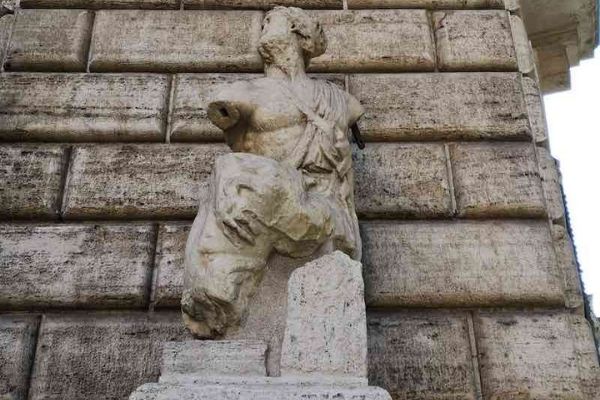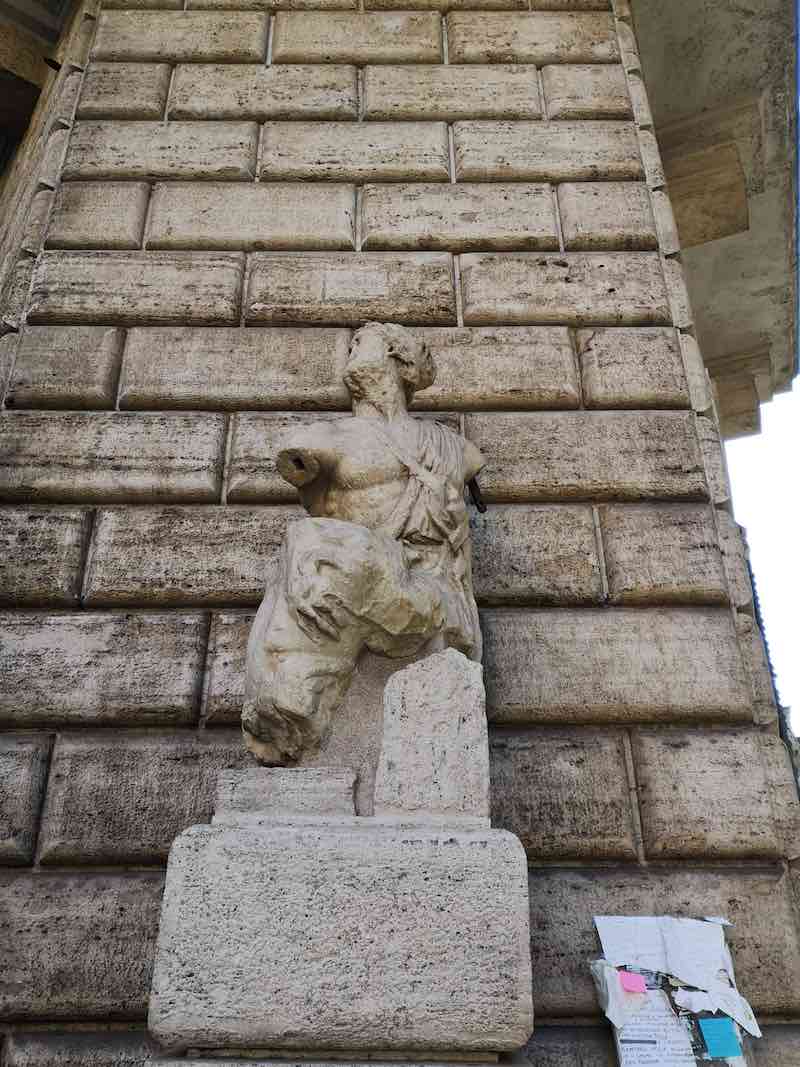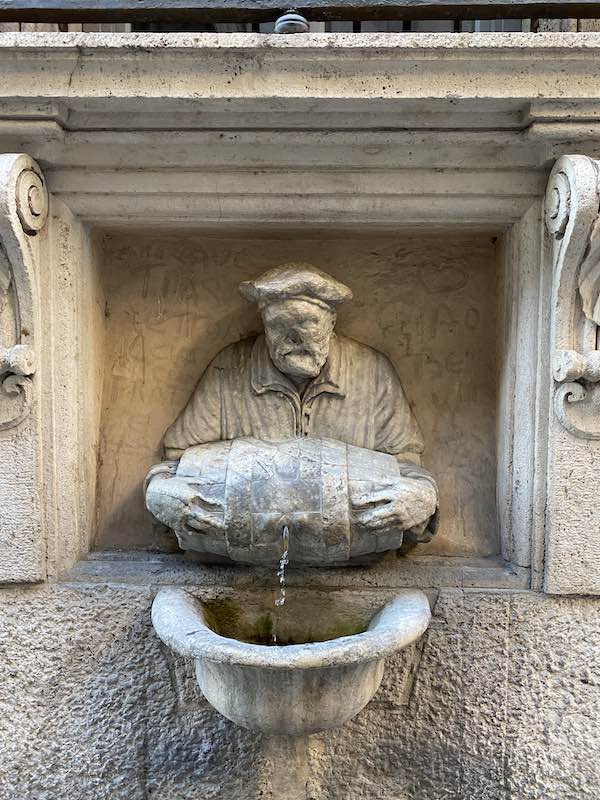All you need to know about the talking statues of Rome. Who they are, what they are, where to find them, what makes them unique.
The ‘talking statues of Rome’ is a series of 6 statues in Rome used in the past to express political opinions and discontent.
They are said to be ‘talking’ because, in Papal Rome, they were a way for dissenting citizens to criticize the state, without fearing persecution.

At night, escaping the watchful eyes of the Papal Guards, people would write anti-papal and anti-establishment messages and pin them onto these statues, effectively turning the statues into a way to give voice to anonymous political expression, often with a witty twist.
There 6 talking statues of Rome are:
- Pasquino
- Marforio
- Madama Lucrezia
- Il Facchino (the porter)
- Il Babuino (the baboon)
- Abate Luigi (abbot Luigi)
As a group, they were referred to as the Congregation of the Wits (Congresso degli Arguti)
The golden age of the talking statues of Rome was the XVI century but the figures still exist and some of them still host messages, sadly often not half as witty as those of the tradition!
Where to see the ‘talking statues of Rome’: names and addresses
| Statue Name | Address |
| Pasquino | Piazza Pasquino |
| Marforio | Capitoline Museums |
| Il Facchino | Via Lata |
| Madama Lucrezia | Piazza Venezia |
| Abate Luigi | Piazza |
| Il Babuino | Via del Babuino |
Pasquino – the most famous talking statue of Rome
The most famous of the talking statues of Rome is Pasquino.

You can find him in the Piazza by the same name: Piazza Pasquino, where he has been since 1501.
Pasquino is the first talking statue of Rome and seems to be ancient Roman in origin.
The sculpture represents the torso of a young man but it is in a poor state and it is therefore impossible to be sure what it would have represented.
Art historians tend to agree it dates from the III century AD and there are reasons to believe it represents Menelaos, the Greek King who brought war against Troy.
This interpretation seems plausible: the story of the foundation of Rome connects the city with the Trojan War, so the representation of the main characters of that epic war was common in the city.
The name Pasquino is of uncertain origin and seems to come simply by the place where they found him: the barbershop of a man called Pasquino!
Pasquino is mentioned often in stories about Rome as a statue that always has witty remarks over current events.
Among the most famous sayings by Pasquino we have ‘Quod non fecerunt barbari, fecerunt Barberini‘ (what the Barbarians didn’t do, the Barberini did).
This sentence came after the decision by the Barberini family to authorize Bernini to collect bronze from the Pantheon for the construction of the baldachin in St Peter’s basilica.
Another famous saying by Pasquino is: ‘Dacci un Papa miglior, Spirito Santo, che ci ami, tema Dio, né campi tant’.
Give, Oh Holy Spirit, a better Pope, who loves us, fears God and doesn’t live as long’ – a comment made after the long reign of Pope Clemens VII.
The Popes feared Pasquino and Pope Hadrian VI even gave order to throw him into the river Tiber!
He died before the order was carried out and irony wants that this Pope is buried in Santa Maria dell’Anima, very close to Pasquino!
Pasquino’s saying are called pasquinate (pasquinade, in English).
Marforio
Marforio another of the talking statues of Rome. He is a bearded man lying on his side and he can be found in the courtyard of the Capitoline Museums, on the Capitoline hill.
Like Pasquino, Marforio also is an ancient Roman statue.
Most likely he is a representation of a river Tiber or another River God and his original location was the Roman Forum.
Marforio and Pasquino were a double act: very often Marforio would pose a question to Pasquino as a sort of assist to the delivery of a punch line.
For instance, when Napoleon took from Rome countless works of art, Marforio asked Pasquino: È vero che i Francesi sono tutti ladri?» Risposta di Pasquino: «Tutti no, ma Bona Parte».
Pasquino, is it true all French are thieves? Pasquino answered: not all, but a good portion (In Italian: Bonaparte, napoleon’s surname’ translates into good part. good portion, good amount).
Facchino
The statue of facchino is a small fountain in Via Lata and represents a man carrying a barrel.

We know very little about this statue but we know it is not ancient.
Most likely, he dates from the XVII century and represents a member of the corporation of acquaioli (water carriers), something suggested by the small barre but also his attire.
It is possible that the author of this fountain was Jacopino Del Conte, who often worked with Giacomo della Porta in Rome however, this attribution is unsure.
Fun fact: the face of this statue is very poorly preserved and this has caused speculation. Some believe that the figure was voluntarily damaged as wrongly believed to be representing Martin Luther.
Indeed, the shape of his hat is similar to that Martin Luther would have worn however, there seems not to be any reasonable explanation on why he would have been represented with a small barrel, the reason why this theory stayed effectively an urban legend.
Madama Lucrezia
Madama Lucrezia is the only woman among the 6 talking statues of Rome and is unique in many respects.
The statue represents a female figure, probably the Egyptian Goddess Isis, it is 4 meters high and most likely comes from the temple of Isis nearby (you can read here >> about Gods and Goddesses of Rome and why Isis was worshipped in the city).
The name Madama Lucrezia has nothing to do with this origin but comes from Lucrezia D’Alagno, a noble Roman woman from the XV century.
Lover to the then King of Naples, she pleaded to the Pope for his divorce which was denied. The anger of the king’s son forced her to move to Rome permanently where she used to live close to the ancient statue who eventually took her name.
Abate Luigi
The talking statue of Abate Luigi is in Piazza Vidoni, close to Piazza Navona.
The statue represents a man in a toga and seems to date from late roman times. His name comes from the abbot of the nearby Chiesa del Sudario, who was said to look a lot like the statue!
Abbot Luigi is the only talking statue of Rome that tells us something about himself. n the statue, we can see the inscription:
‘Fui dell’antica Roma un cittadino
Ora Abate Luigi ognuno mi chiama
Conquistai con Marforio e con Pasquino
Nelle satire urbane eterna fama
Ebbi offese, disgrazia e sepoltura
Ma qui vita novella e alfin sicura’
which reads ‘ I was a citizen of ancient Rome, now everyone calls me abbot Luigi, with Pasquino and Marforio I gained fame for urban satire. I suffered offenses, disgraces and got buried but found here eventually new and safe life.
Il Babuino (the baboon)
The statue of the baboon does not represent a monkey but rather a male figure lying on a side, identified in Sileno.
The name seems to come from the grumpy face of the statue that must have triggered the witty remarks of roman people at the time. He is in front of the church of Sant’Attanasio dei Greci and he is now a fountain.
The Babuino is said to have been rather talkative, so much so that like Pasquino, he got a name for his saying. If Pasquino had pasquinate, bauino had babuinate!
I hope you enjoyed this quick overview of the talking statues of Rome and help you get a bit of an insight into life in papal Rome in the 16th century. Safe travels to Rome!
